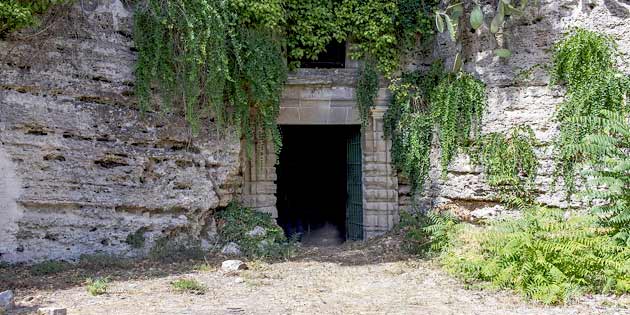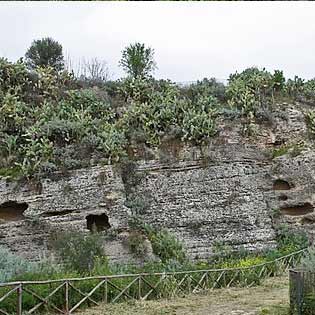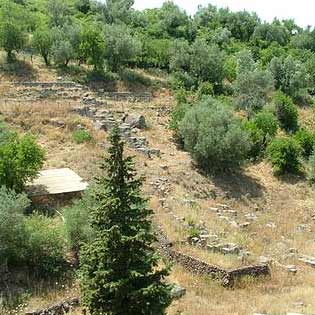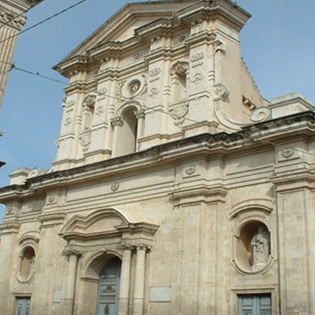Rock Church of the Crucifix in Carlentini

Antreus93 - CC4.0
The rock church of the Carlentini Crucifix presents the most complex iconographic apparatus of rock Sicily.
The church, dating back to the 12th century, stands along the northern slopes of Colle Metapiccola, overlooks the Cava Ruccia, looking at Etna. The Greek city of Leontìnoi once stood in this area and the church of the Crucifix was its religious fulcrum.
The church, entirely excavated in the rock, is made up of two main rooms and other spaces connected to them.
The first environment, the Oratorium Populi, is configured as the real church. It has a quadrangular shape, an apse dug with an ogival arch that contains the altar, and is decorated with several layers of often overlapping frescoes, dated between the 12th and 17th centuries.
The second room, which today has an entrance which is believed to have originally been a window, is believed to have been subject to an eighteenth-century reconstruction which used it as a cult. Above the cave, a cenoby stood, of which some ruins are visible.
South of the Oratorium Populi there is an underground putridarium, i.e. a funerary chapel, and the related ossuaries dug into the back wall.
There are in the cave there are two further rooms: a very large first room which has a hypogeum, probably an ossuary; a second small room with decorations.
The expansion of the complex led to the partial destruction of the frescoes.
The Oratorium Populi is decorated with frescoes depicting Saints which overlap , have created a historic-artistic palimpsest of great interest. The oldest images date back to the century. XII-XIII and follow the Byzantine iconography. The fresco of Christ Pantocrator belongs to this period who, seated on a typically oriental imperial throne, with his severe gaze, manifests his omnipotence surrounded by four cherubs. The iconographic theme, also present in the Cathedral of Cefalù, allows us to place the work in the Norman period. To the north of the apse, strips of the fresco of the Crucifixion are preserved, hence the name of the church. This is followed by a wall on which devotional acts have taken place over the centuries, and on which there are up to five layers of fresco. The most frequent sacred images, on this side, are related to the Virgin Mary.
The rocky septum that separates the two western rooms is decorated on one side only, a decoration which was partly destroyed by the construction of a large arch, where < strong>five Byzantine icons, facing the devotees frontally, distinguished by red and white frames. The decoration is dated to the 13th century. Each icon is accompanied by a background divided into three chromatic fields, according to the blue, ocher, blue scheme, with the exception of the figure of the Virgin, characterized by an entirely blue background. All the figures are distinguished by halos and differ in clothing and position and have onomastic inscriptions abbreviated in the Greek alphabet which allow their identification: Saint Elizabeth in a praying position; Mother Hodegetria with Child; Saint Leonard with the chain, protector of innocent prisoners; St. John the Baptist holding up a scroll; An unidentified Holy Bishop with blessing hand. The inscriptions are in relief, as are the beaded decorations that embellish the garments and headdresses of all the subjects. In the part above there is an older layer of fresco, depicting the same characters.
On the north wall of the Church there is the fresco of the Madonna del Latte, which belongs to the late Gothic period, between the end of the XIV and the beginning of the XV century. The Virgin is represented full-length in the maternal gesture of breastfeeding the Child, a symbolic expression of the sacred humanity of Mary, woman and mother of Jesus. Inside a double red and yellow frame, the image stands out against a covered blue background , in the upper part, by a white curtain dotted with small red crosses, like a starry sky, while, in the lower part, you can glimpse the structure of a seat on which the Madonna is seated, placed in three-quarter position. The Virgin wears a red robe embellished with beads at the cuffs and a mantle that covers her from head to toe. The face of the Madonna, represented in three quarters, turns a tender gaze towards the observer. Part of her breast emerges from her dress, to which the right hand of the Holy Child is humanly clinging, with her head stretched forward to breastfeed, while with the left she grasps the red dress of the Mother. Jesus wears a green tunic decorated with beads.
On the western back wall there are two images dating from the 15th and 16th centuries: the fresco of Christ the Wayfarer and San Cristoforo.
In the small north-western room was depicted a Deposition dating back to the century. XVII, now preserved in the Archaeological Museum of Lentini.


